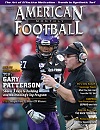Article CategoriesAFM Magazine
|
Drills Report: Murray State’s Defensive Back Press Man Coverageby: Keith HatcherDefensive Backs Coach, Murray State University © More from this issue As defensive back coaches, we often teach our athletes to do things that are unnatural to them and are against what their instincts tell them to do. We tell them to not to follow their key inside if they are a flat defender, do not jump a route that sits in front of them if you are a vertical defender, do not jump a deep crossing route if you are half-field player. Among many other things, a successful defensive back must be disciplined on every play. It is a unique position on the field in that one false step or one false read may result in a play that can cost your team the game. Our mistakes as defensive backs, more so than any other position on the field, are visible to everyone and, on any given play, can change the outcome of the game.
|
|
|||||||
| HOME |
MAGAZINE |
SUBSCRIBE | ONLINE COLUMNISTS | COACHING VIDEOS |
Copyright 2025, AmericanFootballMonthly.com
All Rights Reserved





